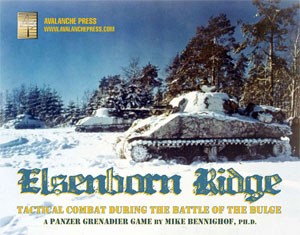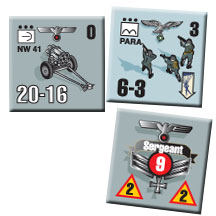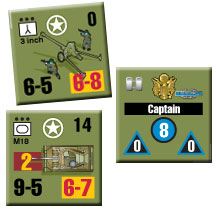| Elsenborn
Ridge:
Scenario Preview, Part Three
By Mike Bennighof,
Ph.D.
June 2020
 I enjoyed designing Panzer Grenadier: Elsenborn Ridge back in the day in large part for the topic: the U.S. Army stood its ground and fought the best the Germans had to offer, including the over-rated Waffen SS and the sinister Führer Escort Brigade. The past stays with us, and even though it’s often over-rated, like Herodotus wrote, great deeds should never be forgotten. In late 1944 and early 1945, the U.S. Army committed great deeds. Let’s look at a few of them. I enjoyed designing Panzer Grenadier: Elsenborn Ridge back in the day in large part for the topic: the U.S. Army stood its ground and fought the best the Germans had to offer, including the over-rated Waffen SS and the sinister Führer Escort Brigade. The past stays with us, and even though it’s often over-rated, like Herodotus wrote, great deeds should never be forgotten. In late 1944 and early 1945, the U.S. Army committed great deeds. Let’s look at a few of them.
Scenario Eighteen
St. Vith: The Devil's Own
20 December 1944
Ordered to attack St. Vith, Col. Otto Remer of the Führer Escort Brigade had his own ideas - a political soldier, he hoped to attract even more of his adored leader's favor by reaching the Meuse River before any other unit. He therefore brought his brigade around the town's northern perimeter and attacked a weak spot in the American lines. If successful, Remer's brigade would bypass St. Vith completely and race into the rear areas.
Conclusion
Remer's dreams came to a crashing halt in the form of 90mm shells from the 814th Tank Destroyer Battalion. The new, speedy M36 vehicles ambushed the German tank column and shot up its leading vehicles. The German attack fell apart and Remer pulled back to wait for the rest of his brigade to arrive before making a renewed (and unauthorized) dash for glory.
Notes
What’s a bumbling and incompetent authoritarian leader without even-more bumbling and incompetent minions? Here the minionist of the minions runs into strong opposition, and though Remer has excellent troops and top-flight equipment the Americans have a secret weapon (the M36 tank destroyer) and in this generation, the determination to resist evil.
Scenario Nineteen
Bastard Tanks
20 December 1944
 Having lost Stoumont, 30th Division moved quickly to take it back. Another battalion of the 119th Infantry moved up to replace Fitzgerald's, and brought with it the 740th Tank Battalion. The tank battalion had just arrived at the front, with crews but no tanks, and Gen. Courtney Hodges of First Army ordered them to scrounge whatever vehicles they could from repair depots and join the attack. The Americans found a number of Shermans sent to U.S. repair centers by trusting British units, and stole those along with some duplex-drive amphibious tanks also left by the Brits. Maintenance crews worked throughout the night, cannibalizing vehicles whenever necessary, and when dawn broke 20 "bastard tanks" stolen from their British owners rolled out to support the Guardsmen. Having lost Stoumont, 30th Division moved quickly to take it back. Another battalion of the 119th Infantry moved up to replace Fitzgerald's, and brought with it the 740th Tank Battalion. The tank battalion had just arrived at the front, with crews but no tanks, and Gen. Courtney Hodges of First Army ordered them to scrounge whatever vehicles they could from repair depots and join the attack. The Americans found a number of Shermans sent to U.S. repair centers by trusting British units, and stole those along with some duplex-drive amphibious tanks also left by the Brits. Maintenance crews worked throughout the night, cannibalizing vehicles whenever necessary, and when dawn broke 20 "bastard tanks" stolen from their British owners rolled out to support the Guardsmen.
Conclusion
Fighting quickly focused on the Catholic-run St. Edouard Sanitorium, a complex of stout stone buildings overlooking the road to Stoumont (hex 1105 on Board 24). It changed hands several times, with combat taking on the surreal quality known to veterans of countless battlefields. At one point the Sister Superior and her nuns knelt in prayer, repeating the rosary while a company of SS men charged uphill chanting "Heil Hitler." Snarling North Carolina Guardsmen answered with machine gun fire and then bayonets as the fighting raged from room to room. As night fell both sides had lost hundreds of men and the Americans pulled back to re-organize for another try.
Notes
These Nazis find that their speech is not protected by the National Guard. The SS have a strong position and a good deal of armor to support their defense. The Americans have a lot of artillery to go with their stolen tanks. It’s okay to steal something if you use it to fight Nazis.
Scenario Twenty
Night of the Long Knives
20 December 1944
As the "All American" Division joined the fight against Peiper, its staff found the Germans holding the key village of Chernoux. The 504th Parachute Infantry detailed two companies to capture it, but the attack faltered as night fell and the Germans poured fire on them from the many light anti-aircraft guns present in the town.
Conclusion
Deprived of artillery support, the paratroopers pressed captured German weapons into use but could get nowhere until a berserker fury overcame Sgt. George Walsh. Screaming "let's get those sons of bitches!" he stormed forward alone, tossing grenades and drawing his fighting knife to tackle in hand-to-hand combat the German "flakwagons" punishing his company. One German crew died in a grenade blast, another in a flurry of knife slashes, and soon the troopers were swarming over the Germans. But American losses were so severe that they could not hold all of the ground they had taken, and it took reinforcements that arrived in the morning to finish the job.
Notes
It’s just a small scenario; the Nazis have some assault guns and anti-aircraft batteries pressed into ground combat; the Americans have a very angry sergeant with a very big knife.
Scenario Twenty-One
Crossroads: The Last Gasp
21 December 1944
After days of disorder, the Hitler Youth division finally assembled its full strength in front of the Dom Bütgenbach farm. The division command decided on another night attack in hopes of negating the American advantage in artillery. The Waffen SS scorned the regular Army's general staff traditions and schools, but after the division took two full days to finally assemble some battalions promptly wandered off into the darkness. The attack only got underway more than three hours late, with dawn breaking and well after the preparatory artillery barrage had ended.
Conclusion
Once again, the Hitler Youth proved a dismal failure. The division was ordered out of the line again and sent south to attack Bastogne, where it would fail once more to break a determined American defense. The SS division left 782 dead lying in front of the American positions, and had lost over half its tanks in its defeats at the twin villages and the Dom Bütgenbach farm. American losses were also heavy, yet a single American infantry regiment had wrecked one of Hitler's supposedly elite panzer divisions.
Notes
There’s just one board in play, but lots of units on it as the Hitler Youth make a two-pronged assault on some determined American defenders. There are many tanks involved in pretty dense terrain, and a rain of artillery fire.
Scenario Twenty-Two
St. Vith: The Fall
21 December 1944
The American 7th Armored Division had raced to St. Vith and flung its units into defensive positions haphazardly as they arrived. A handful of troops from the shattered 106th Infantry Division joined them, and a few small units of the 9th Armored Division also became intertwined. Nevertheless they put up stout resistance, but when the Germans sorted out their own confusion and launched a mass attack numbers made a difference.
Conclusion
Though unsettled by the rocket fire, the Americans resisted with the aid of tanks and tank destroyers. When the huge Royal Tiger tanks finally rumbled into the battle zone, the Germans blinded the American tankers with flares and while they were still stunned the huge 88mm guns annihilated the Shermans. The American commander apparently suffered a nervous breakdown and fled the battlefield, yet his junior officers refused to give up the now-uncoordinated fight and 7th Armored Division's Combat Command B lost over 900 men in fierce close-quarters fighting. By midnight the Germans had secured St. Vith.
Notes
This time it’s a big scenario, with all the boards in play and the Germans flooding the zone with . . . not very good units, plus a battalion of Royal Tiger tanks. The Americans have armor support and as always lots of artillery, but there are an awful lot of awful Germans.
Scenario Twenty-Three
Norwegian Nightmare
21 December 1944
With Battle Group Peiper trapped and Sixth SS Panzer Army unwilling to authorize a breakout, fresh reinforcements were flung into a relief attempt including Otto Skorzeny's "deception" brigade. His troops, clad in American uniforms, had been intended to seize the bridges over the Meuse River but now found themselves in regular ground combat.
Conclusion
Skorzney's misfit band had a run of gross misfortunes: first, they ran into the only American unit containing a large proportion of Norwegians, whose poor grasp of English made them immune to Skorzeny’s deception tactics. Next, they were attacking a scant few hundred yards from the site where SS men had murdered 86 unarmed American prisoners on the 17th; 43 men (including actor Charles Durning) escaped to bring the tale to other US units. Finally, Allied headquarters had issued permission to use the deadly proximity fuze that made American artillery utterly devastating to infantry in the open. This would be its first use. Skorzeny's men attacked while shouting "surrender or die" and the Norwegians drove them back. The Germans in turn tried to surrender, milling about and screaming "Kamerad!" The Norwegians instead gave them the second alternative, in the form of machine-gun fire and an artillery barrage.
Notes
Those airbursts are deadly, and the Americans have Roland the Thompson Gunner fighting for them, too. It’s not a good day for the SS, and that’s how it should be.
Scenario Twenty-Four
Spearhead
21 December 1944
 In Stoumont, the beleaguered SS troops of Battle Group Peiper came under intense, long-range direct fire from one of the "bastard" vehicles of the 740th Tank Battalion - a self-propelled 155mm GPF rifle of unknown origin, probably stolen from its parent unit. Running out of fuel, the SS could neither move forward nor retreat. The Americans planned a fresh assault that started to go wrong when an infantry battalion and its tank support attacked from wildly different directions instead of together. In Stoumont, the beleaguered SS troops of Battle Group Peiper came under intense, long-range direct fire from one of the "bastard" vehicles of the 740th Tank Battalion - a self-propelled 155mm GPF rifle of unknown origin, probably stolen from its parent unit. Running out of fuel, the SS could neither move forward nor retreat. The Americans planned a fresh assault that started to go wrong when an infantry battalion and its tank support attacked from wildly different directions instead of together.
Conclusion
The 2nd Battalion of the 119th Infantry Regiment lost its commander early in the attack when he stumbled into a German patrol. Meanwhile the 3rd Armored Division's Task Force Jordan missed the infantry during its march south and, rather than keep looking for them, Capt. John Jordan ordered his troops to attack without them. Both units failed in their missions – one prong lacked tank support, the other sufficient infantry. The SS would soon slink away from Stoumont of their own accord.
Notes
Make sure you use those golden pieces from Spearhead Division when you play this scenario. The American player has the advantage of knowing where all of his or her troops are, while the SS are running out of gasoline. This is another tough one for the bad guys, as it should be.
Scenario Twenty-Five
Elsenborn Ridge
22 December 1944
No map included the label "Elsenborn Ridge" in late 1944; V Corps commander Leonard T. Gerow coined the phrase to indicate the line of hills near the Elsenborn Barracks where he wished his troops to establish a fallback position. After the bitter fighting for the Twin Villages and Dom Bütgenbach farm the Americans made an orderly withdrawal to the new line. Soon afterwards the Germans threw a fresh division into attempt to widen their breakthrough.
Conclusion
An experienced division that had fought in Italy and Alsace, 3rd Panzer Grenadier nevertheless sent its troops forward in brutal frontal assaults and suffered accordingly. When the snow melted during the following spring, Belgian villagers would find German bodies stacked three and four deep in front of the American positions. Massive artillery fire again made the difference, as the gunners fired at well above rates their weapons' manuals said was physically possible and rained thousands of shells on the attackers with deadly accuracy.
Notes
The Germans have numbers and they have tanks; the Americans have some 57mm popguns and lots and lots of artillery. It’s going to be a hard day for the Herrenvolk.
And that’s the third segment.
Click
here to order Elsenborn Ridge right
now!
Sign up for our newsletter right here. Your info will never be sold or transferred; we'll just use it to update you on new games and new offers.
Mike Bennighof is president of Avalanche Press and holds a doctorate in history from Emory University. A Fulbright Scholar and NASA Journalist in Space finalist, he has published a staggering number of books, games and articles on historical subjects.
He lives in Birmingham, Alabama with his wife, three children and his dog, Leopold.
|
